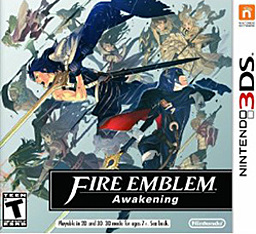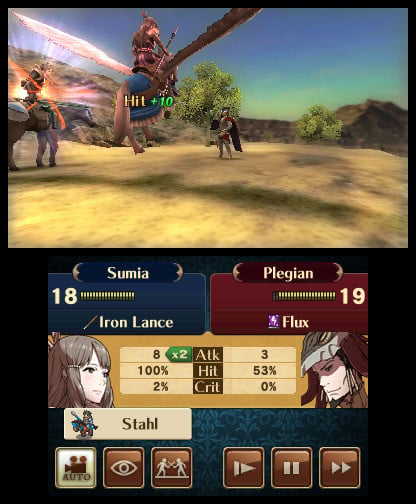Game Review
by Dave Riley,Fire Emblem: Awakening
3DS
| Description: |  |
||
Fire Emblem's first release on the 3DS. Its familiar tactical gameplay is married to the most in-depth character advancement systems in the series to date. |
|||
| Review: | |||
Fire Emblem is one of the rare RPGs where dead characters actually stay dead. Who has the patience for that? People have jobs, schoolwork, social obligations. Who has the time to reset the game every time they lose a wizard? The problem with permadeath is that, at some point, a character will die on the last or second to last enemy on the map and the pain of resetting the game is greater than the pain of losing your only myrmidon. The "problem" with permadeath is it makes you think and it makes you care. Where games like Final Fantasy Tactics and Tactics Ogre offer long buffer times to rescue downed troops, a unit in Fire Emblem is gone, forever, once its Hit Points reach 0. They're about as fragile as any mass-produced zergling, but they all have names, and customizable skills, and off-duty conversations about baking pies and dark incantations. A mage dies about as quickly as an Advance Wars infantry unit, but this mage's name is Miriel. She really likes science. She is edging ever-closer to a relationship with Frederick.
So Fire Emblem's pace is glacial, compared to most strategy RPGs, because the thought of losing even one unit can be too much to bear. Final Fantasy Tactics troops are meat for the grinder, to be killed and resurrected multiple times in one battle if it suits the cause. Fire Emblem units are rare birds: each to be carefully cultivated, each to be zealously protected. Each turns ends with surrounding a healer on all sides by armor-clad knights or, failing that, pressing the X button to layer a purple warning zone over the battlefield, to show which spaces the enemy can reach, and keeping the more dainty units well-clear of those spots. Only a handful of Fire Emblem games have been released in the States, but we've gotten enough of them that we know their basic jist. Knights, priests, and magic users move across a grid-based tactical map. Swords beat axes beat lances beat swords and archers are unfairly overpowered when it comes to shooting pegasi out of the air (at least, they're overpowered when it's your pegasus they're shooting down). Characters level up and advance in job classes, so the cavalier becomes a paladin and the delicate dark mage can advance to the steed-riding, mostly-durable, frontline-charging dark knight. Tutorials are doled out slowly and the bottom screen on the 3DS is used to display a stunning amount of statistics, such that you'll know everything about every encounter before you enter it. Such that you'll look at a bosses 1% chance to crit and think "no, too risky." There are a few new tricks here. Units can support adjacent troops, like in past games, or they can form into teams and storm across the battlefield in pairs. Units gain stat boosts just by standing next to each other and every shared combat action furthers their bond, pushing them a little closer to offering +10 crit or +15 avoid. Characters can marry, if they spend enough time giving each other +10 crit buffs, and they can have kids. When the kids are all grown-up they can fight for you too and give +10 crit buffs to their brothers and sisters, if you like. Then, after they're all leveled up and have become best friends, you can then send them out into asynchronous multiplayer battles against other players' versions of themselves. Adjacent allies can also attack in tandem or nullify enemy blows, though both happen at random and, predictably, the blows you really, really want nullified are never the ones that are. Character abilities are supplemented by skills, granting further stat boosts or, in the case of Dark Fliers, the insanely unfair ability to take another turn after killing an enemy.
Awakening isn't particularly hard, as Fire Emblem games go, but it's not a pushover. Especially not in the uncomfortable middle section of the game where enemies aren't especially deadly, but character avoidance and defense hasn't reached the level where they can shrug off multiple blows on the same turn. This sometimes leads to dire situations where an enemy ticks off a third of a character's health before being slain by a counter-attack, only to be replaced by another enemy who ticks off another third and is then slain, only to be replaced by another enemy... So good planning is paramount, hedging your bets is essential, and finding spaces on the map with few vulnerabilities takes up the lion's share of each turn. Most of the game is a creeping, careful crawl that moves the entire army in a ironclad block three spaces at a time. Movements are so fraught, and battles so carefully measured, that when the tide turns in your favor it's hard know what to do with the power. There's a special thrill when, halfway through a stage, the final enemy bowman is killed and the wyvern riders are free to soar across the level at their maximum movement speed and rain havoc down on anything they encounter. And there's a thrill each and every time a cavalier scores a critical hit, charging their horse across the screen with a flash of purple lightning, and an anime portrait of their intensely focused eyes, followed by their foe's slow motion demise. Every action has a battle animation. The pirouetting, hand-thrusting wizards and swooping wyverns are the most fun but, spears or swords or bows, just about everyone looks cool doing just about anything. There's even something endearing about the trundling war clerics, with their oversized battle axes and ridiculous skirt bustles. So it hurts when, in your most triumphant moments, you overreach and end up getting someone killed. Awakening has a "Casual" modifier, discrete from its Normal/Hard/Lunatic difficulty modes, that removes permadeath. Something like that should be there, because it accounts for the fact that we are all human beings with lives, but it changes the game so the rush-down becomes okay, because at the end of the day everybody lives (even when they die). And we want everybody to live! But Fire Emblem was never about the rush-down and it's not necessarily about everybody making it out alive. This is war, after all, and people die. Fire Emblem is more about looking back at the end of the game and remembering the spaces in the lineup where there was once an archer, or a great knight, or a dragon girl. The dragon girl was a bit too young and a bit too scantily clad, really, but she had this kind-of funny plotline going with the dark mage about her toenail clippings and it would've been nice to see where that went...
Fire Emblem is... kind of funny, at times? It is definitely cute, when 2D battlefield sprites pop bright pink hearts over their head after a support action. It has its moments of charm during the optional stuff, like talking with the spear-wielding maiden who's into bawdy romance novels or the shy knight in the comically oversized armor who somehow fades into the scenery. It can be a little lazy at times, with its reliance on anime in-jokes like characters walking into other characters in the shower, but never so badly that it ruins things. But it is on-point, when it needs to be, and for once here's a game that delivers its foreshadowing as foreshadowing instead of making the plot twist so obvious that it is a twist in name only. When it is serious it is good at being serious and it does a decent job of juggling two main characters -- one of them Chrom, prince of a small kingdom beset on all sides, and the other an amnesiac player-insert avatar (whose choice of hair color and style are represented both in 3D cutscenes and in anime character portrait) -- without it feeling like either is getting the short shrift. It's a solid, if standard, story about warring factions set against the backdrop of an ancient slumbering evil. It doesn't really aspire to the depth of intrigue we get from Yasumi Matsuno-style church-vs-state Strategy RPGs, but it has its moments. Many of these moments are on the battlefield. Many of these moments involve a sole unit whose life rests on a 49% chance to dodge. In these times we can regard permadeath as a problem (to be solved by resets and perfect runs) or we can regard it as a lesson: to be a little more careful next time, to move a little more frugally, and to treat our troops as something other than grist for the mill. |
|
The views and opinions expressed in this article are solely those of the author(s) and do not necessarily represent the views of Anime News Network, its employees, owners, or sponsors.
|
| Grade: | |||
Overall : A-
Graphics : A-
Sound/Music : B
Gameplay : A
Presentation : B+
+ Classic Fire Emblem gameplay in gorgeous 3D. Character interactions during downtime tend towards funny/cute. |
|||
|
discuss this in the forum (35 posts) |
this article has been modified since it was originally posted; see change history |
|||


